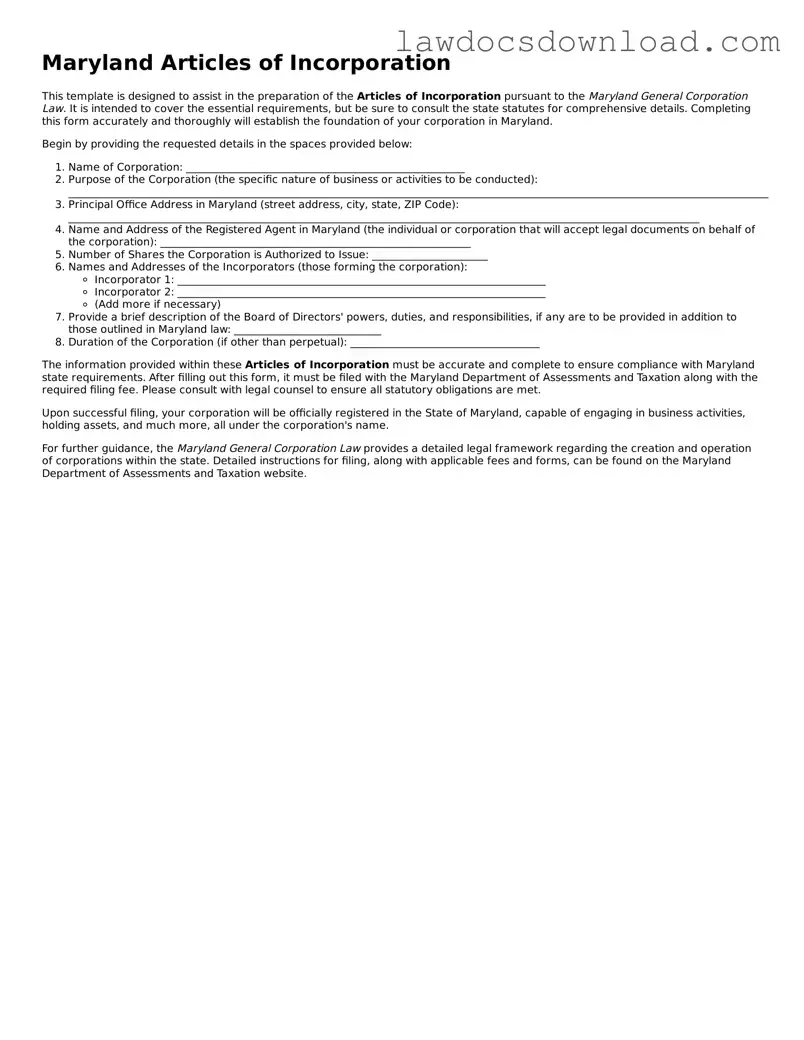When diving into the business world in Maryland, the Articles of Incorporation form stands as a foundational document for incorporating a business. However, this document doesn’t exist in isolation. It shares similarities with several other legal documents, each serving its unique purpose yet overlapping in structure or objective. One such document is the Articles of Organization, typically used for LLCs (Limited Liability Companies). Just like the Articles of Incorporation, the Articles of Organization outline the fundamental aspects of the company, such as the business name, purpose, and management structure. These documents serve as a public declaration of the entity's existence and business structure to the state.
Another related document is the Bylaws, which, unlike the Articles of Incorporation that are filed with the state, are internally maintained documents. Bylaws detail the rules and regulations governing the internal management of a corporation, covering aspects like board structure, meetings, and shareholder rights. This contrasts with the Articles of Incorporation's focus on establishing the company's basic legal framework but similarly aims to provide a structured approach to company management.
The Operating Agreement of an LLC parallels the Articles of Incorporation in some ways, focusing on the governance and operation of an LLC. It outlines member duties, financial distributions, and the decision-making processes. Though specific to LLCs and not required by the state, this document complements the Articles of Incorporation by detailing the inner workings of the business, ensuring that all members are on the same page.
A Business Plan, while more strategic than legal, also shares a connection with the Articles of Incorporation. It serves as a roadmap for the business, outlining objectives, market analysis, and financial projections. While not filed with the state, a well-crafted business plan supports the goals outlined in the Articles of Incorporation by providing detailed strategies and benchmarks for success.
The Employer Identification Number (EIN) application (Form SS-4) is directly related to the process initiated by the Articles of Incorporation. Once a business is incorporated, it must obtain an EIN from the IRS for tax purposes. This critical number is akin to a Social Security number for the business, necessary for hiring employees, opening bank accounts, and filing taxes. The EIN application, while a form, signifies the business’s commitment to legal and tax responsibilities following incorporation.
Shareholder Agreements also share a relationship with the Articles of Incorporation. These agreements lay out the rights and responsibilities of the shareholders, including how shares can be bought, sold, or transferred. Though more detailed and focused on shareholder relations, a Shareholder Agreement operates under the framework established by the Articles of Incorporation, enhancing the company’s corporate governance structure.
The Certificate of Good Standing is another document that, while not similar in content to the Articles of Incorporation, becomes relevant in the life of a corporation following its initial filing. This certificate is proof from the state that the corporation is in compliance with applicable laws and has been maintaining its legal and filing responsibilities. Companies often need this certification when applying for loans or renewing licenses, emphasizing the corporation's legitimacy and operational status post-incorporation.
Lastly, the Annual Report is a document required by most states, including Maryland, to be filed by corporations on a yearly basis. Although it serves a different purpose by updating the state on the company’s current address, directors, and financial status, it is a continuation of the dialogue between the corporation and the state that begins with the filing of the Articles of Incorporation. This report ensures that the company remains in good standing and keeps the state informed of its ongoing operations.
Each of these documents, while serving distinct roles, collectively contributes to the foundation and ongoing compliance of a business. From inception to daily operations and annual reporting, they are interconnected in ensuring that a business not only starts on solid ground but remains structured, compliant, and poised for growth.
